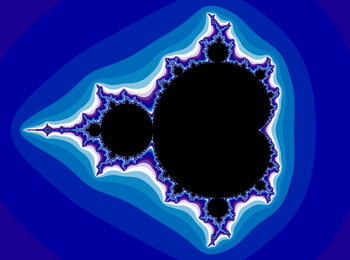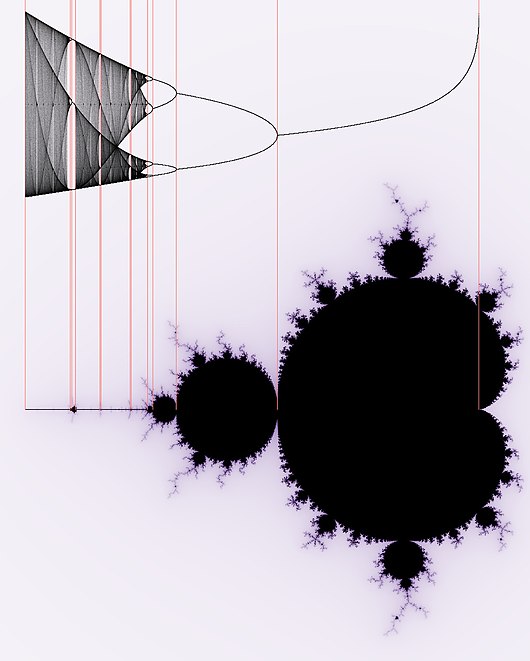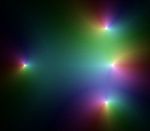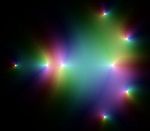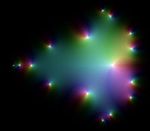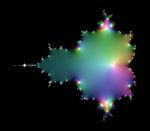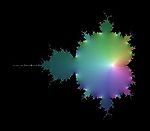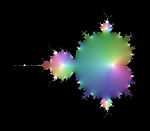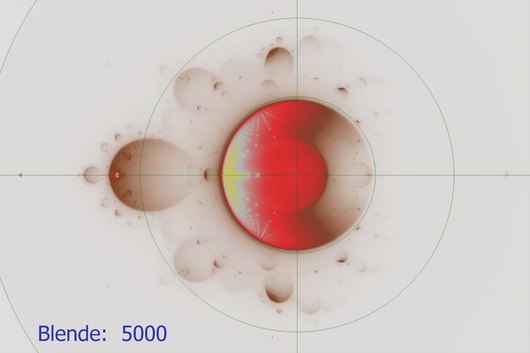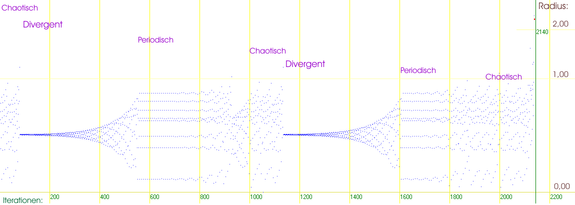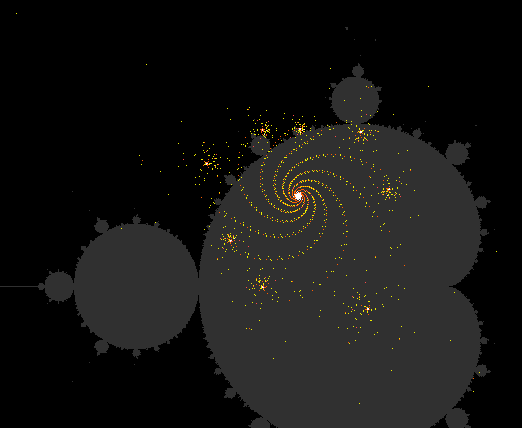Mandelbrot set
The Mandelbrot set, named after Benoît Mandelbrot, is the set of complex numbers 
defined sequence 
Interpreted geometrically as part of the complex number plane, the Mandelbrot set is a fractal, often called the apple man in common parlance. Images of it can be generated by placing a grid of pixels on the number plane and thus 


The first computer graphic representations were presented by Robert Brooks and Peter Matelski in 1978. In 1980, Benoît Mandelbrot published a paper on the subject. It was later systematically studied by Adrien Douady and John Hamal Hubbard in a series of fundamental mathematical papers. The mathematical foundations for it were worked out as early as 1905 by the French mathematician Pierre Fatou.
Mandelbrot set (black) with colored environment. Each pixel is assigned a complex number 


Definition
Definition via recursion
The Mandelbrot set 


and the initial member
remains bounded. That is, a complex number 




One can easily show that the magnitude of 



Definition about complex quadratic polynomials
The Mandelbrot set can also be described by complex quadratic polynomials:
with a complex parameter 

iteratively computed, where 


Depending on the value of the parameter this sequence then either grows unbounded, so that


The Mandelbrot set is a subset of the complex numbers with the definition
or equivalent

Some properties and examples are given for explanation:
- Based on the previously described observation, can be
set. Here the value
gives the radius around the origin within which an element of
can lie. Outside this circle no elements of
found.
- Because of the magnitude function,
symmetric about the real axis.
- To graphically represent the set
graphically, the values of the parameter must
all be calculated individually up to a self-determined number of iterations.
- If
then the sequence is
and is bounded. Therefore,
element of
.
- For
the iterative sequence
Divergence and
is not an element of
.
Definition about Julia sets
The Mandelbrot set 






This principle is developed in many results on the behavior of the Mandelbrot set 




Relation to chaos theory
The law of formation, which is the basis of the sequence, is the simplest nonlinear equation, on the basis of which the transition from order to chaos can be provoked by variation of a parameter. For this purpose it is sufficient to consider real number sequences.
They are obtained when restricted to the 






The period doubling starts with the "head" and continues in the sequence of "buds" towards the "antenna". The ratio of the lengths of successive parameter intervals and thus that of the bud diameters to different periods thereby tends towards the Feigenbaum constant δ 
For certain complex 
The Mandelbrot set is therefore an elementary object for chaos theory, on which fundamental phenomena can be studied. For this reason, it is sometimes compared to straight lines in Euclidean geometry in terms of its importance for chaos theory.
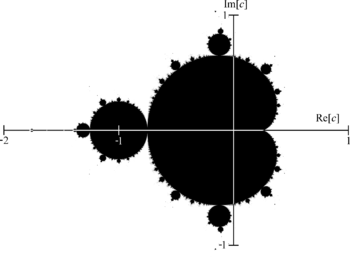
The Mandelbrot set (black) in the complex plane
Behavior of the number sequence
The various structural elements of 


- It converges to a fixed point.
- It converges to a periodic limit cycle consisting of two or more values. This also includes the cases in which the sequence behaves periodically from the beginning.
- It never repeats, but remains limited. Some values show chaotic behavior with alternation between almost periodic limit cycles and seemingly random behavior.
- It diverges towards infinity (certain divergence).
All 

The following table shows examples of these four limiting behaviors of iteration 

| Parameter | Sequence members | Boundary behavior |
| On the real axis ... | ||
| | | certain divergence against |
| | | immediate convergence to fixed point |
| | | Convergence against triple limit cycle |
| | | chaotic behavior |
| | | Convergence against 32 limit cycle |
| | | Convergence against alternating limit cycle |
| | | instantaneous convergence against alternating limit cycle |
| | | very slow convergence to fixed point |
| | | Convergence to fixed point |
| | | Convergence to fixed point |
| | | immediate convergence to fixed point |
| | | Convergence against fixed point |
| | | certain divergence against |
| In the complex number plane ... | ||
| | | instantaneous convergence against alternating limit cycle |
| | | Convergence vs. triple limit cycle |
Geometric assignment
Convergence exists precisely for the values of 


In the uncountably many remaining points of the Mandelbrot set, the sequence can behave in many different ways, each of which generates very different dynamical systems and some of which are the subject of intensive research. Depending on the definition of the word, "chaotic" behavior can be found.
Periodic behavior
The circular structures
Each circular "bud" and each satellite cardioid is characterized by a certain periodicity of the limit cycle against which the sequence tends for the associated 
The periodicity of a "bud" is the sum of the periodicities of the two nearest larger "neighboring buds" in both directions on the same basic body, if there are any. If there are only smaller "buds" at the edge of the base body up to the point of contact with its base body or up to the notch of the cardioid, then instead of the periodicity of a "neighboring bud", that of the base body itself contributes to the sum. The following properties are derived directly from this:
- In tendency, the greater the periodicity of the "buds" or cardioids, the smaller they are.
- The periodicity of the largest "bud" on a base body is always double, like the "chignon" with period
on the "head".
- The periodicity of a satellite "bud" is the product of the periodicity of the satellite cardioids and that of the corresponding "bud" of the main cardioids.
Furthermore, this rule explains the occurrence of certain sequences of "buds" such as from the "head" towards the cardioid notch with a periodicity increase towards the next "bud" by the value 

Attractive cycles
If for a 













- Period 1: The cardioid of the main male apple. The edge of this cardioid is given by points of the form
with
.
- Period 2: The "head". The 2nd zero
corresponds to the main cardioid which, because of period
naturally occurs as a zero when determining all higher periods. This consideration shows that the number of attractors with period can be
most 2 n
, and that only if n {\displaystyle
prime number. The head itself is a circular disk with center
and radius
, i.e., the edge of this circular disk is given by points of the form
with
.
- Period 3: The "buds" corresponding to the "arms" and the cardioids of the largest satellite on the "head antenna". The fourth zero
omitted again.
The number of attracting cycles with exact period 


Iteration gallery
The following gallery gives an overview of the values of 



| The iteration z → z² + c after n steps | |||||||||||||||||||||
|
| ||||||||||||||||||||
From the series of images above, it can be seen for iteration level 



Repulsive cycles
Besides attractive cycles, there are repulsive ones, which are characterized by sequences of numbers in their vicinity moving increasingly away from them. They can be achieved, however, since every 



A Misiurewicz point 










Satellites
Another structural element which accounts for the richness of forms of the Mandelbrot set are the reduced copies of itself which are found in the filigree structures of its edge. Thereby, the behavior of the number sequences within a satellite corresponds to that of the sequences in the main body in the following way. Within a satellite, all number sequences converge to limit cycles whose periods differ from those at the corresponding places in the main body of differ 





The additional structural elements in the immediate vicinity of a satellite are a consequence of the fact that between two of the considered sequence elements with the index distance 


The Mandelbrot set itself is a universal structure which can appear in completely different nonlinear systems and classification rules. However, the basic prerequisite is that the functions involved are angle-faithful. If such systems are considered which depend on a complex parameter 

As in the adjacent picture, the Mandelbrot set can appear distorted, for example, the arm buds are located in a slightly different place. Otherwise, however, the Mandelbrot set is completely intact, including all buds, satellites, filaments and antennae. The reason for the appearance of the Mandelbrot set is that the considered function families in certain areas - apart from rotations and displacements - agree quite well with the function family

which defines the Mandelbrot set, coincide. Deviations are allowed within a certain range, and nevertheless the Mandelbrot set crystallizes. This phenomenon is called structural stability and is, in effect, responsible for the appearance of the satellites in the neighborhood of 
Intermediate changeable behavior
Due to the possibility of the sequence of numbers to repeatedly get into the immediate vicinity of a repulsive cycle, and in turn to almost get into another cycle during the subsequent tending divergent or chaotic behavior, intermediately very complicated behaviors of the sequence can be formed until the final character of the sequence is revealed, as the two figures demonstrate. The environment of the associated 

The representation of the following points even in the complex plane shows greater complexity in these cases. The quasiperiodic behavior in the neighborhood of a repulsive cycle in these cases often leads to spiral structures with several arms, where the following points orbit the center while the distance to it increases. The number of arms is therefore equal to the period. The point clusters at the ends of the spiral arms in the figure above are the result of the two associated near-captures by repulsive (unstable) cycles.
Density distribution of the sequence members
The adjacent picture shows how often a pixel is hit by an intermediate result of all iterations. In the range of |Z|<2.0 each pixel is hit at least once and added up. Within M, values up to 30000 can occur in this image. However, at a contrast of 1:30000, subtleties in the M edge can no longer be easily seen. At apertures up to 1000, structures can be seen that lie far outside the M. These are generated by the intermediate results of the periodic iterations of satellite sets.
In the orbit image all iteration results were filtered out which are not contained in the selection range at point 1. So you can see that these orbits start from a satellite of period 3 (point S). In the next pictures these 4 orbit summations are shown zoomed. This example is valid for all satellites. However, for most satellites a much higher iteration limit is needed (here only 100). This increases the generated contrast considerably, making such subtleties increasingly difficult to show.

Figure 3 of the orbit

Figure 2 of the orbit
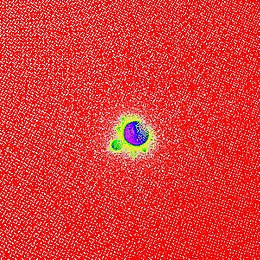
Figure 1 of the orbit
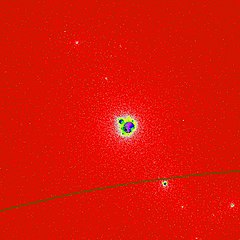
Orbit origin in satellite (S)

Orbit image
Accumulated density distribution of the sequence members for all 
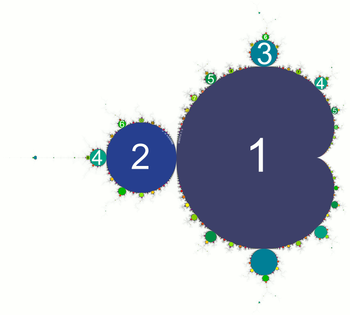
Mandelbrot set with color-coded period length of limit cycles
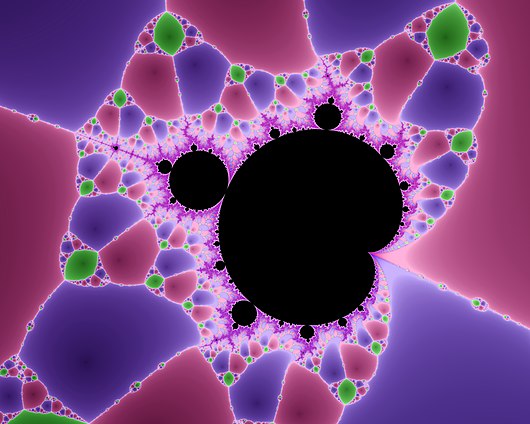
Analysis of the behavior of Newton's method to a family of cubic polynomials.
Representation of the amount of the sequence members as a function of the iteration step 

Search within the encyclopedia

